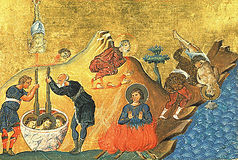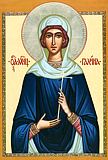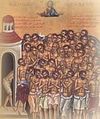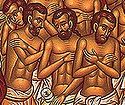

| Previous day | Next day |
| Old Style
March 9
|
Friday |
New Style
March 22
|
|
1st Week of Great Lent.
Tone 8.
Great Lent. |
Monastic rule: xerophagy (bread, uncooked fruits and vegetables).
|
![]() The Holy Forty Martyrs of Sebaste: Cyrion (or Quirio), Candidus, Domnus, Hesychius, Heraclius, Smaragdus, Eunoicus, Valens, Vivianus, Claudius, Priscus, Theodulus, Eutychius, John, Xanthias, Helianus, Sisinius, Angus, Aetius, Flavius, Acacius, Ecdicius, Lysimachus, Alexander, Elias, Gorgonius, Theophilus, Dometian, Gaius, Leontius, Athanasius, Cyril, Sacerdon, Nicholas, Valerius, Philoctimon, Severian, Chudion, Aglaius, and Meliton (ca. 320).
The Holy Forty Martyrs of Sebaste: Cyrion (or Quirio), Candidus, Domnus, Hesychius, Heraclius, Smaragdus, Eunoicus, Valens, Vivianus, Claudius, Priscus, Theodulus, Eutychius, John, Xanthias, Helianus, Sisinius, Angus, Aetius, Flavius, Acacius, Ecdicius, Lysimachus, Alexander, Elias, Gorgonius, Theophilus, Dometian, Gaius, Leontius, Athanasius, Cyril, Sacerdon, Nicholas, Valerius, Philoctimon, Severian, Chudion, Aglaius, and Meliton (ca. 320). ![]() Martyr Codratus (Quadratus) and with him Martyrs Cyprian, Dionysius, Anectus, Paul, Crescens, and Dionysius (another), at Corinth (258).
Martyr Codratus (Quadratus) and with him Martyrs Cyprian, Dionysius, Anectus, Paul, Crescens, and Dionysius (another), at Corinth (258).
Martyr Urpasianus of Nicomedia (ca. 295). St. Caesarius, brother of St. Gregory the Theologian (ca. 369). St. Tarasius the Wonderworker, of Lycaonia. Translation to Vladimir of the relics of Martyr Abraham of the Bulgars on the Volga (1230). St. Jonah, archbishop of Novgorod (1470). St. Theodosius Levitsky, priest, of Balta (Odessa) (1845). St. Dimitra, nun and foundress of the Vvedensk Convent in Kiev (1878).
New Hieromartyrs Mitrophan Buchnoff, archpriest, of Voronezh (1931), and Ioasaph (Shakhov), abbot, of Popovka (Moscow) (1938). New Hieromartyrs Sergius Lebedev, Sergius Tsvetkov, and Alexis Smirnov, archpriests, and Dimitry Glivenko, priest, all of the Moscow region (1938).
“Albazin” Icon of the Most Holy Theotokos (“The Word Was Made Flesh”) (1666).
St. Philoromus the Confessor, of Galatia (4th c.). St. Pacianus, bishop of Barcelona (390). St. Bosa, bishop of York (705). St. Vitalis of Castronovo (994). New Martyrs (two priests and forty students) of Momisici (Montenegro) (1688).
Repose of Elder Cleopas of Ostrov-Vvedensk Monastery (1778), Schema-abbot Theodosius (Pomortsev) of Optina Monastery (1920), and Schema-archimandrite Theophilus of Kiev (1996).
Thoughts for Each Day of the Year
According to the Daily Church Readings from the Word of God
By St. Theophan the Recluse

Friday.
The souls of the righteous are in the hand of God (Wisdom 3:1). But in whose hand are the souls of sinners? The Saviour said to the apostles that satan seeks to sift them like wheat, that is, he seeks to knock them from the right path, to take them into his hands and do with them what he wants. That is why everyone turning away from the Lord is in the hands of satan, and he sifts them and casts them wherever he desires. Due to this the heads of sinners are constantly spinning, because the enemy, dragging them here and there, does not give them a chance to come to their senses. As soon as the enemy notices that someone is starting to have second thoughts, he starts to shake him even more strongly, so that his head again becomes clouded and his thoughts become scattered.
Friday.
The Lord scorneth the scorners: but He giveth grace unto the lowly (Prov. 3:34). Particularly remember these words when you go to confession. Nothing like pride binds your tongue to keep it from saying, “I am a sinner.” Humble yourself before the Lord, do not spare yourself, do not fear the face of man. Reveal your shame for it to be washed; show your wounds for them to be healed; tell of all your unrighteousness that you be justified. The more merciless you will be with yourself, the more compassion the Lord will show towards you, and you will leave with a sweet feeling of forgiveness. This is that grace of our Lord Jesus Christ, given from Him to those who humble themselves through sincere confession of their sins.[1]
[1] In Russia people traditionally went to confession on the evening of this first Friday of Great Lent, in preparation for Holy Communion the next day. See the footnote for Tuesday of this week.
Articles
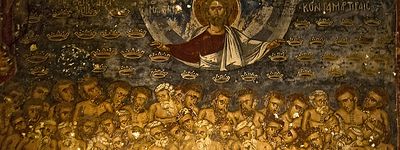 40 Holy Martyrs of Sebaste |
 Martyr Quadratus and those with him at CorinthSaint Quadratus, despite inhuman suffering, encouraged the others, urging them not to be afraid and to stand firmly for the Faith. |
 Martyr Urpasianus of NicomediaThe Holy Martyr Urpasianus suffered in the city of Nicomedia. |
 St. Caesarius, brother of St. Gregory the TheologianSaint Caesarius lived for a long time at the court of the emperor Constantius (337-361), and was his friend and chief court physician. |
 Icon of the Mother of God “The Word was made Flesh”The Albazin Icon of the Mother of God “the Word made Flesh” is of great religious significance in the Amur River region. |
